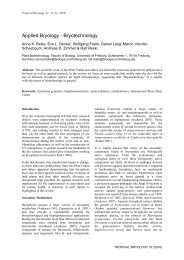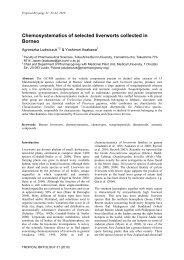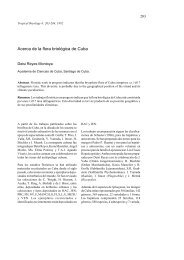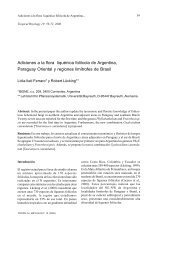100 years of tropical bryophyte and lichen ecology - Tropical Bryology
100 years of tropical bryophyte and lichen ecology - Tropical Bryology
100 years of tropical bryophyte and lichen ecology - Tropical Bryology
Create successful ePaper yourself
Turn your PDF publications into a flip-book with our unique Google optimized e-Paper software.
48<br />
between the Tropic <strong>of</strong> Cancer <strong>and</strong> Tropic <strong>of</strong><br />
Capricorn are included. A great deal <strong>of</strong> work<br />
has been conducted in sub<strong>tropical</strong> countries (e.g<br />
Japan <strong>and</strong> New Zeal<strong>and</strong>), but is not included.<br />
The list suggests <strong>lichen</strong>s are ecologically<br />
poorly studied compared to <strong>bryophyte</strong>s. For both<br />
groups, the Neotropics has received a great deal<br />
<strong>of</strong> attention relative to other <strong>tropical</strong> regions.<br />
Investigations <strong>of</strong> community <strong>ecology</strong> <strong>and</strong><br />
diversity are the most common, <strong>and</strong> research on<br />
the reproductive biology, animal interactions, <strong>and</strong><br />
conservation <strong>of</strong> <strong>tropical</strong> <strong>bryophyte</strong>s <strong>and</strong> <strong>lichen</strong>s<br />
has been less so. In terms <strong>of</strong> substrate affintiy,<br />
epiphytes are well studied compared to<br />
lithophytes <strong>and</strong> epixylic comunities. Overall,<br />
every aspect <strong>of</strong> <strong>tropical</strong> <strong>bryophyte</strong> <strong>and</strong> <strong>lichen</strong><br />
<strong>ecology</strong> is very poorly known <strong>and</strong> a great deal <strong>of</strong><br />
future research is necessary.<br />
All citations were verified with hard copies <strong>of</strong><br />
reprints, communication with the primary author,<br />
or a citation database (e.g. AGRICOLA, BIO-<br />
SIS), except those marked with an asterisk (*).<br />
An appendix that groups citations by category is<br />
provided. The corresponding author welcomes<br />
any corrections or additions to the list.<br />
FIGURE 1. <strong>Tropical</strong> <strong>bryophyte</strong> <strong>and</strong> <strong>lichen</strong><br />
ecological publications in the 20 th century.<br />
ACKNOWLEDGEMENTS<br />
We thank the following individuals for their help in<br />
verifying citations <strong>and</strong>/or sending reprints; Andre<br />
Aptroot, Steve Churchill, Heinjo During, Dana Griffin<br />
III, Timo Koponen, Robert Lücking, Dan Norris,<br />
Tamas Pócs, Harrie Sipman, <strong>and</strong> Jan Wolf. This project<br />
supported by National Science Foundation grants (BIR<br />
9975510, DEB 9974035, INT 9981531, DEB<br />
9615341).<br />
BIBLIOGRAPHY<br />
Allorge, V. & P. Allorge. 1939. Sur la répartition<br />
et l’écologie des hépatiques épiphylles aux<br />
Açores. Bol. Soc. Brot., Coimbra, 13: 211-<br />
231.<br />
Ak<strong>and</strong>e, A.O. 1984. Anhydrobiosis in<br />
corticolous <strong>bryophyte</strong>s. <strong>Tropical</strong> Ecology<br />
Mervin & Nadkarni<br />
25: 255-259.<br />
Ak<strong>and</strong>e, A.O. 1985. Osmotic potential - A<br />
factor for resistance to water stress in some<br />
Nigerian species <strong>of</strong> corticolous <strong>bryophyte</strong>s.<br />
<strong>Tropical</strong> Ecology 26: 80-84.<br />
Ak<strong>and</strong>e, A.O., S. Olarinmoye & A. Egunyomi.<br />
1982. Phytosociological studies on some<br />
corticolous <strong>bryophyte</strong>s in Ibadan, Nigeria.<br />
Cryptogamie Bryol. Lichénol. 3: 235-248.<br />
Ak<strong>and</strong>e, A.O., S.O. Olarinmoye & A.<br />
Egunyomi. 1985. Nutrient studies <strong>of</strong> some<br />
corticolous <strong>bryophyte</strong>s in Nigeria.<br />
Cryptogamie Bryol. Lichénol. 6: 121-133.<br />
Akinsoji, A. 1991. Studies on the epiphytic flora<br />
<strong>of</strong> a <strong>tropical</strong> rain forest in southwestern<br />
Nigeria. II. The bark micr<strong>of</strong>lora. Vegitatio<br />
92: 181-185.<br />
Aptroot, A. 1997. Lichen biodiversity in Papua<br />
New Guinea, with the report <strong>of</strong> 173 species<br />
on one tree. Biblioth. Lichenologica 68: 203-<br />
213.<br />
Aptroot, A. & H.J.M. Sipman. 1997. Diversity<br />
<strong>of</strong> <strong>lichen</strong>ized fungi in the tropics. Pp. 93-<br />
106 in K.D. Hyde, ed. Biodiversity <strong>of</strong><br />
<strong>tropical</strong> micr<strong>of</strong>ungi. Hong Kong University<br />
Press, Hong Kong.<br />
Arvidsson, L. 1991. Lichenological studies in<br />
Ecuador. Pp. 123-134 in D.J. Galloway, ed.<br />
<strong>Tropical</strong> <strong>lichen</strong>s: their systematics,<br />
conservation, <strong>and</strong> <strong>ecology</strong>. Claredon Press,<br />
Oxford.<br />
Barillas, R., R. Lücking & S. Winkler. 1993.<br />
Vergesellschaftungen foliikoler Flechten im<br />
Biotopo del Quetzal, Guatemala.<br />
Cryptogamie Bryol Lichénol 14: 49-68.<br />
Baudoin, R. 1985. Analyse de la distribution<br />
des <strong>bryophyte</strong>s épiphylles sur la soufrière de<br />
Guadeloupe. C.R. Séances Soc. Biogéogr.<br />
61: 47-57.<br />
Bentley, B.L. 1987. Nitrogen fixation by<br />
epiphylls in a <strong>tropical</strong> rainforest. Ann. Mo.<br />
Bot. Gard. 74: 234-241.<br />
Bentley, B.L. & E.J. Carpenter. 1980. Effects<br />
<strong>of</strong> desiccation <strong>and</strong> rehydration on nitrogen<br />
fixation by epiphylls in a <strong>tropical</strong> rainforest.<br />
Microbial Ecology 6: 109-113.<br />
Bentley, B.L. & E.J. Carpenter. 1984. Direct<br />
transfer <strong>of</strong> newly-fixed nitrogen from free<br />
living epiphyllous micro-organisms to their<br />
host plant. Oecologia 63: 52-56.<br />
TROPICAL BRYOLOGY 21 (2002)
















